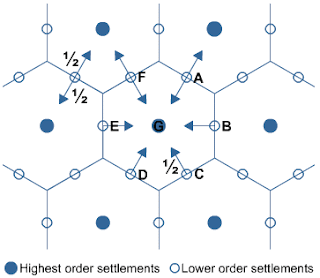Urban structure is made up of various different zones.
Within MEDCs there are generally 5 zones: the Central Business District (CBD),
inner city, inner suburbs, outer suburbs and countryside. Each zone tends to
have its own particular land use. The CBD is an area of high density, high rise
buildings which occur because competition for land is high here. CBDs are
normally pedestrianized, contain the main shopping areas, have a bus and train
station, plenty of banks, offices and entertainment venues and cafes. Car
parking is generally found on the edge of the CBD. The CBD is where most
business and commerce is found. A good example for picturing the CBD is the
pedestrianize areas of Leicester City Centre - particularly around the clock
tower.
The inner city is found next to the CBD and mainly consists
of houses in a grid like pattern (think Coronation Street). In the 19th
Century these terraced houses were built to house factory workers who worked in
the inner city factories. They are generally 2 up 2 down houses with an outside
toilet and are found near the canal or railway. When the terraces were built,
there would have also been a factory nearby, as well as a public bath and park
in the area. Each street would have also had a pub or corner shop. During the
1960s many of the factories started to close down, which led to unemployment
and other socioeconomic problems, which in turn meant periods of unrest in many
inner city areas. Many of the old terraces were knocked down and replaced with
flats and maisonettes. In recent years
many of these areas have undergone a period of regeneration, some have had
retail parks built on the former industrial estates, for example Watford Arches
Retail Park. Run down terraces are often bought by investors who adapt the
houses for modern living, adding an inside bathroom and in some cases adapting
houses for the student market. A great local example is Clarendon Park in
Leicester - a very popular area for students of the University of Leicester to live
in. Many of these terraced houses have been adapted to house 2, 3, 4 or 5 students.
Other investors will improve the terraces to appeal to young professionals who
need to access the CBD. This process of renovating the inner city areas is
called gentrification.
The next zone is the inner suburbs. This area contains
housing which is nearly all detached or semi-detached. Mostly built in the
1920s and 1930s, the housing is medium sized, generally has a garden and a few
have a garage. Places of worship, schools and parks are often present as well
as shopping centres which can sometimes be found here.
The outer suburbs are made up of detached houses. These tend
to be large new houses with garages, gardens and trees. In the late 20th
Century housing estates were built in the suburbs, arranging the detached
houses along roads arranged in cul-de-sacs and wide avenues. New shopping
centres, council estates, modern factories and open parks and spaces are found
within the outer suburbs.
The final zone is the countryside. There are few houses
found here, mostly fields, trees and according what I wrote in my GCSE work
book, sheep.
Geographers have created models of what a typical city
should look like. One of the most famous is the Burgess model, also known as
the concentric zone model. As you can see from my drawing above, the order in
which I went through the zones fits with the Burgess model. The idea is that
land values are highest in the centre of the town or city, because competition
his high in the central parts of the settlement. This leads to layout as
mentioned above, with the highest density of buildings in the centre and
density decreasing the further out one goes.
The Burgess model…
Clearly, this will not fit every city, as not every city is
a ‘typical city’. On top of this, the Burgess model was developed before mass
car ownership, which does affect the model as I will look into below. Finally,
the model does not take into account the many people who choose to live and
work outside the city.
The Hoyt model (see below) aims to solve a few of the issues
with the Burgess model. It is still based on the concentric rings, but also
takes into account the transport and physical factors which affect a
settlements layout, as well as the knowledge that houses were built along main
roads to ensure easy access to the CBD. The model also takes into account that
factories were built along railways and canals, so that raw materials and the
finished products could be transported easily. Some of the other outward developments
acknowledge the fact that many cities grew outwards on the flattest land, as it
was easier and cheaper to build on.
The topic in teaching…
From looking in my work book, when I learnt about this, it
was a case of copying down diagrams from the board and working through things
as a class. I’m not really sure how far I could deviate from this, but one
activity I did see that I thought was really good is shown below…
This was given to us as a sheet of 9 jigsaw pieces which we
had to cut out and fit together to make the town. Following from this we then
coloured in the sections to show how the town grew - from just the centre in
the 1700s, to the growth of the 1900s and then the extension to add the
suburban estates in the 1950s. The key on the bottom left hand side of the
picture notes the corresponding colours to years of development.
References
http://www.bbc.co.uk/schools/gcsebitesize/geography/urban_environments/urban_models_medcs_rev1.shtml
http://www.bbc.co.uk/schools/gcsebitesize/geography/urban_environments/urban_models_medcs_rev2.shtml
http://www.bbc.co.uk/schools/gcsebitesize/geography/urban_environments/urban_models_medcs_rev3.shtml
http://www.bbc.co.uk/schools/gcsebitesize/geography/urban_environments/urban_models_medcs_rev4.shtml
http://www.s-cool.co.uk/gcse/geography/settlements/revise-it/urban-morphology
















.jpg)